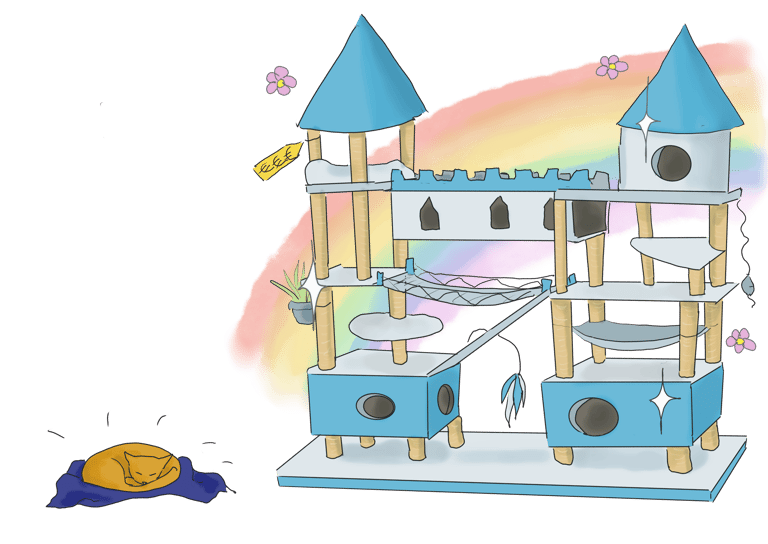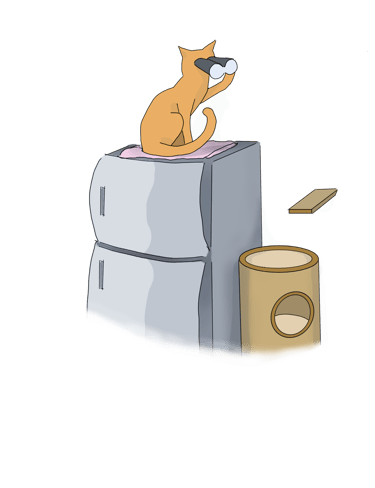How to pick a cat tree
The critereas you should consider to pick a long lasting, well used cat tree: security, design, materials... I tell you everything.
Marlène Laurent
3/4/20246 min read


You will find any sort, at any price, and when it is time to pick one, it can be overwhelming. Wouldn't it be a waste if you spend a lot in a cat tree your cat won't even look at, or destroy in a few months?... So how can you make sure your investment will be appreciated? In the article, I explain, as a cat behaviourist, the critereas you should consider when you buy a cat tree so you make the best choice for your pet.
To know how to pick a cat tree, you should know why you should buy one. Why is it for exactly? Well, cat trees answer to several natural cat needs: marking, climbing, playing, sleeping, transit area, shelter, hiding spot or observation point, the tree can fill up many functions...
...But the number 1 function is a scent marker
Cats are olfactive animals, they mostly communicate through scents. Cats trees, with their soft surfaces, their scratching posts, are appreciated for their scent soaking abilities. They are an important marking area in the living space : by scratching it, by sleeping and rubbing on it, the cat deposits its smell signature and by doing so, makes the all room its own home. Be carefull with cat trees made with cheap smelly materials : your cat will most likely be bothered by them!
the first criterea:localisation-location-location
You can have the most beautiful cat tree in the world, if it sits in a forgotten, far from any living areas place in your home, there is no point of marking it and it will be simply ignored by your cat.
Before buying anything, pick a place where the family spends time (kitchen, livingroom, bedroom), where there is traffic, anyplace that is strategically interesting for marking.
To insure your cat will use the new cat tree, it is even better if it allows access to another space or ressource: a shelf, the top of a furniture, a look-out post etc


Safety first
A tree is meant to be climb, but a good climber is a safe climber. The climbing difficulty of the tree should be adapted to the cat's age and physical condition so it is challenging enough but not to hard for daily use or while aging. Wobbly trees should be ruled out: they are both scary and more likely to break. Trees need steady bases and tall ones should be wall secured to avoid falling. High platforms shouldn't be slippery : they must be covered in a material the cat can dig its claws in (carpet, sisal, fabric etc.). Industrials can be cheap regarding the velcrostraps holding the cushions and covers, buy and set some extra ones if you see they are not secured enough.
We also recommand trees with multiple ins and outs, and alternative routes, because cats don't like dead-ends. If your cat gets scared and can't flee a situation (i.e.: dog, children, guests blocking the way out) while being on the tree, there are fair chances it won't come back anymore!
Scratching posts: quality before quantity
In addition to their marking and climbing pole functions, cratching posts allow the cat to stretch their back and front leg muscles. So yeah... size matters. They sould be tall enough (minimum 70 cm for a normal size cat) if you had to pick, better choose the tree with only one scratching post but tall enough, than the tree with 6 poles but way to small. If you buy online, be carefull : pics with kittens can be misleading on the actual size of the tree and always check the measures.


give your cat choices
To make sure the tree is fun to hang out on at any time of the day, of the year or in whatever situation, pick one that has different options. Several look-outs (different views, hidden or not), beds (hammock, platform, cocoon), traffic routes (on the tree or accesses) options will alway be appreciated. If you have more than one cat though, a tree with duplicate options would be easier to share and should be considered to avoid ressources fight.
What about the included toys, you may ask? Well, cats tend to get easily bored with stationnary toys so unless they are switchable, you would rather hang toys yourself and change them periodically. Nonetheless, toys can't hurt and even can be appreciated for a while, specially by kittens. In my opinion, toys aren't really a criterea in terms of cat tree choice.
Durable, so you don't buy a cat tree every couple year
For both the planet's and your wallet's sake, your new cat tree needs to be durable. The sturdiness of the materials is a top criteria to consider if you want your cat tree last for years. The minimal weight of a cat tree is supposed to be at least 4 times the weight of your cat so he can jump on it without knoking is out, more if it is tall. Here are some guidelines:
→ Favor wood, plywood, MDF because they can be repared, and avoid tree that are made of cardboard : they are more fragile. Little secret : fully carpetted, covered cat trees often hide a cardboard made structure... but shhh, you didn't get it from me. ;)
→ A long-lasting tree is cleanable. Cushions and covers should be removables and easily (machine?) washable. The day they are too worned out, you will be able to buy/make new ones instead of buying a new cat tree (just so you know, some etsy sellers sew and sell extra cushions for your cat tree).
→ Structure and design of the cat tree is no stranger to its durability. For example, a high platform only supported by one pole will not handle well the long-term jumps and plays of your cat. Not only it can be wanky but it might end up breaking, scaring the hell out of your cat for no good reasons, and making it associate the tree to a bad thing. The more a platform has points of support, the more it will be steady and sturdy.
→ Make peace with the fact that scratching posts will inevitably be destroyed, better them than the rest of your furnitures, believe me! However, the thicker the sisal rope is, the longer it will last. Avoid the thin ropes, they will be sectionned by your furry friend's claws and your cat tree will look trashy in no time. Some manufacturers sell spare scratching posts, you can think ahead and pick one of their cat tree. Otherwise, fear not : sisal ropes and very litlle handyness are all it takes to renovate a well made cat tree.




Little tips to conclude
- It always helps to consider your cat(s)' personnality and material, activities, confort preferences while you pick a cat tree. Some cats are enthousiastic climbers, others prefer hiding spots, or outside views.
- Never force a cat to go on the tree : it would associate this constraint to the tree and never come back anymore. You cat ignore the new tree? don't panic, it is pretty commun : just give it time to get used to it.
- If we should't force, we can encourage the cat to explore the tree to speed things up: catnip, baldrian, treats, playing sessions on the tree, etc. Everything that works to create positive associations.
To get personalized advices about how to make your home more cat friendly, check and get yourself the "a home for all: enrichments, catification, DYI " educational session!


Houser B., Vitale K. R. (2022). Increasing shelter cat welfare through enrichment: A review. Applied Animal Behaviour Science, 248:105585. doi: 10.1016/j.applanim.2022.105585
Zhang, L., & McGlone, J. J. (2020). Scratcher preferences of adult in-home cats and effects of olfactory supplements on cat scratching. Applied Animal Behaviour Science, 104997. doi:10.1016/j.applanim.2020.104997
